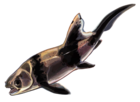Homosteus
| Homosteus Temporal range: Eifelian-?Givetian
| |
|---|---|

| |
| H. milleri | |
| Scientific classification | |
| Kingdom: | |
| Phylum: | Chordata
|
| Class: | |
| Order: | |
| Family: | |
| Genus: | Homosteus
|
| Type species | |
| Homosteus formosissimus Asmuss 1856
| |
| Species | |
| |
| Synonyms | |
| |
Homosteus is a genus of flattened arthrodire placoderm from the Middle Devonian. Fossils are found primarily in Eifelian-epoch aged strata of Europe, Canada, Greenland, and Estonia.[1] All of the species had comparatively large, flattened heads with, as suggested by the upward opening orbits, upward-pointing eyes. These adaptations suggest that the various species were benthic predators. A study on Titanichthys, in contrast, suggests that species of Homosteus may have been filter-feeders instead.[2]
Species[]
H. formosissimus[]
The type species of the genus. It is a thin-plated species from the Eifelian-aged Aruküla beds of Estonia. Although H. sulcatus was described earlier in 1837, H. formosissimus is the official type species as it was the first to be described as a placoderm (H. sulcatus was originally described as a soft-shelled turtle). H. formosissimus had a small, thin keel down the dorsal-center of its median dorsal plate.[1]
H. arcticus[]
This species is based on a 15 centimeter-long preorbital plate from the early Eifelian of the Wood Bay formations of Spitzbergen, Norway. Compared to other species, the anatomy of the plate suggests the species is very primitive for the genus. Denison, 1978, suggests that the species may be different enough to merit its own distinct genus.[1]
H. cf. arcticus[]
Based on a specimen found in the Emsian epoch-aged layers of the Wood Bay formations of Spitzbergen. May or may not be of this genus.[1]
H. kochi[]
This species is from the Givetian of Middle Devonian Greenland, of , to be precise. H. kochi has a comparatively very narrow nuchal plate.[1]
H. latus[]
A giant species from the Eifelian-aged Aruküla beds of Estonia, and may have existed sympatrically with H. formosissimus. H. latus differed from H. formosissimus in having comparatively thick plates, a large, massive crest-like keel along the dorsal-center of its medial dorsal plate, and head-plates over a meter in length. Originally described as "Trionyx latus Kutorga 1837"[1]
H. manitobensis[]
This species is found in the Eifelian-aged Elm Point Limestone of Manitoba. Based on a pair of paranuchal and marginal plates originally referred to the genus Dinichthys. H. manitobensis is the only member of the genus found in North America proper.[1]
H. milleri[]
H. milleri is from the Givetian of what is now the Orkney and Shetland Islands. It is a medium-sized species with a comparatively very rectangular-shaped median dorsal plate.[1]
H. sulcatus[]
Another species from the Eifelian-aged Aruküla beds of Estonia. Although H. sulcatus was described before H. formosissimus, H. sulcatus was originally described as a soft-shelled turtle, ne "Trionyx sulcatus Kutorga 1837". H. sulcatus had thick plates, and a well-developed keel on the dorsal-center of its median dorsal plate. It was larger than H. formosissimus, but still much smaller than H. latus.[1]
References[]
- ^ a b c d e f g h i Denison, Robert (1978). Placodermi Volume 2 of Handbook of Paleoichthyology'. Stuttgart New York: Gustav Fischer Verlag. p. 71. ISBN 978-0-89574-027-4.
- ^ Coatham, Samuel J.; Vinther, Jakob; Rayfield, Emily J.; Klug, Christian (2020). "Was the Devonian placoderm Titanichthys a suspension feeder?". Royal Society Open Science. 7 (5): 200272. doi:10.1098/rsos.200272. PMC 7277245. PMID 32537223.
- Homostiidae
- Eifelian life
- Placoderms of Europe
- Fossils of Estonia
- Fossils of Norway
- Fossils of the United Kingdom
- Placoderms of North America
- Fossils of Canada
- Fossils of Greenland
- Fossil taxa described in 1856


